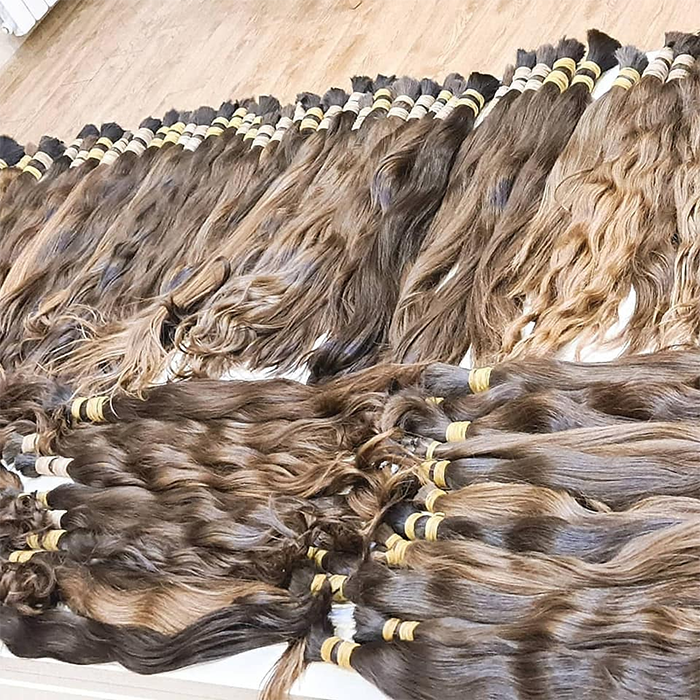Offering hair replacement systems or hair extension services can elevate your business and transform your salon into a luxury service provider. The key to selecting the right hair pieces lies in the details, with the type of hair being a crucial factor. The three most popular options are European, Indian, and Chinese hair. This guide will help you understand the differences between these types of hair, aiding you in making an informed decision for your hair replacement systems.
Why Use Human Hair for Your Products?
The first decision for any salon or store is choosing between human hair and synthetic hair. Although synthetic hair is affordable and offers endless color options, human hair is more natural-looking, with better texture options and a longer lifespan. Human hair, such as Indian hair, allows for greater flexibility in designing and styling hair replacement systems.
European, Indian, and Chinese hair are the most commonly used types for hair systems. Here, we delve into what makes each of these hair types unique.
European Hair
European hair is sourced from donors in Europe, typically those with healthy hair. The highest quality European hair is virgin hair, which is free from chemical treatments or processes. Virgin European hair maintains its natural shine through multiple washes, with the cuticle layer intact, preserving its original texture. This hair type is collected from salons, making it a rare and high-quality option.
Characteristics of European Hair:
Soft texture
Thin hair strands
Natural shine
Minimal chemical processing
Higher price point due to limited availability
European hair is ideal for premium salons and e-commerce stores aiming for a luxury branding. Its natural look and feel make it a top choice for high-quality hair replacement systems.
Indian Hair
Indian hair, including Remy and non-Remy types, is sourced from India. Basic Indian hair undergoes chemical treatments to achieve a soft, silky finish and artificial shine, which diminishes after washing. Remy Indian hair, cut 'root-to-tip,' undergoes minimal chemical treatment, maintaining its health and durability. It blends seamlessly with natural hair due to its cuticle structure.
Characteristics of Indian Hair:
Soft and smooth texture
Suitable for darker hair colors
Ideal for various hair lengths
Can be dyed without damage
Affordable compared to European hair
Indian hair is a versatile and budget-friendly option, offering a balance between quality and cost. It is particularly suitable for clients with African hair textures due to its natural compatibility.
Chinese Hair
Chinese hair is the most affordable option, characterized by its thick and coarse texture. It undergoes extensive chemical processing to make it suitable for hair systems, which can compromise its natural structure. Despite this, Chinese hair is readily available in large quantities, making it a practical choice for budget-conscious clients.
Characteristics of Chinese Hair:
Thick and coarse texture
Extensive chemical processing
Dark pigmentation
Lower price point
Durable but less natural in appearance
Chinese hair is often avoided in the international market due to its lower quality. However, it can be a viable option for cost-effective hair systems if sourced from reputable manufacturers.
Comparison: European Hair vs. Indian Hair vs. Chinese Hair
European Hair vs. Indian Hair:
Shine: European hair maintains its natural shine, while Indian hair's shine diminishes with washes.
Quality: Virgin European hair is of premium quality, while Remy Indian hair offers a balance of quality and affordability.
Texture: Both have similar thickness, but Indian hair undergoes more treatment to achieve a silk-like finish.
Indian Hair vs. Chinese Hair:
Processing: Indian hair undergoes minimal treatment, while Chinese hair requires extensive processing.
Texture: Indian hair is finer and more flexible, whereas Chinese hair is thicker and coarser.
Durability: Indian hair generally has a longer lifespan and is easier to maintain.
Choosing the Right Hair Type for Your Hair Replacement Systems
When deciding on the hair type for your systems, consider the following factors:
Hair density
Flexibility and versatility
Dyeability
Pigmentation
Cuticle condition
Overall health and quality
Texture and smoothness
Availability
Price point
Each characteristic will help you determine the best hair type for your clients. While Chinese hair is an affordable starting point, European hair is the top choice for premium quality. Indian hair offers a middle ground with good quality at an attainable price.
Are you ready to elevate your salon or business with premium human hair systems? Ouxun Hair is here to help you achieve your goals. With extensive experience and a global distribution network, we offer top-quality wigs, toupees, and hair extensions. Contact us at info@ouxunhairs.com for more information on our hair type options.
Post time: Jun-24-2024










